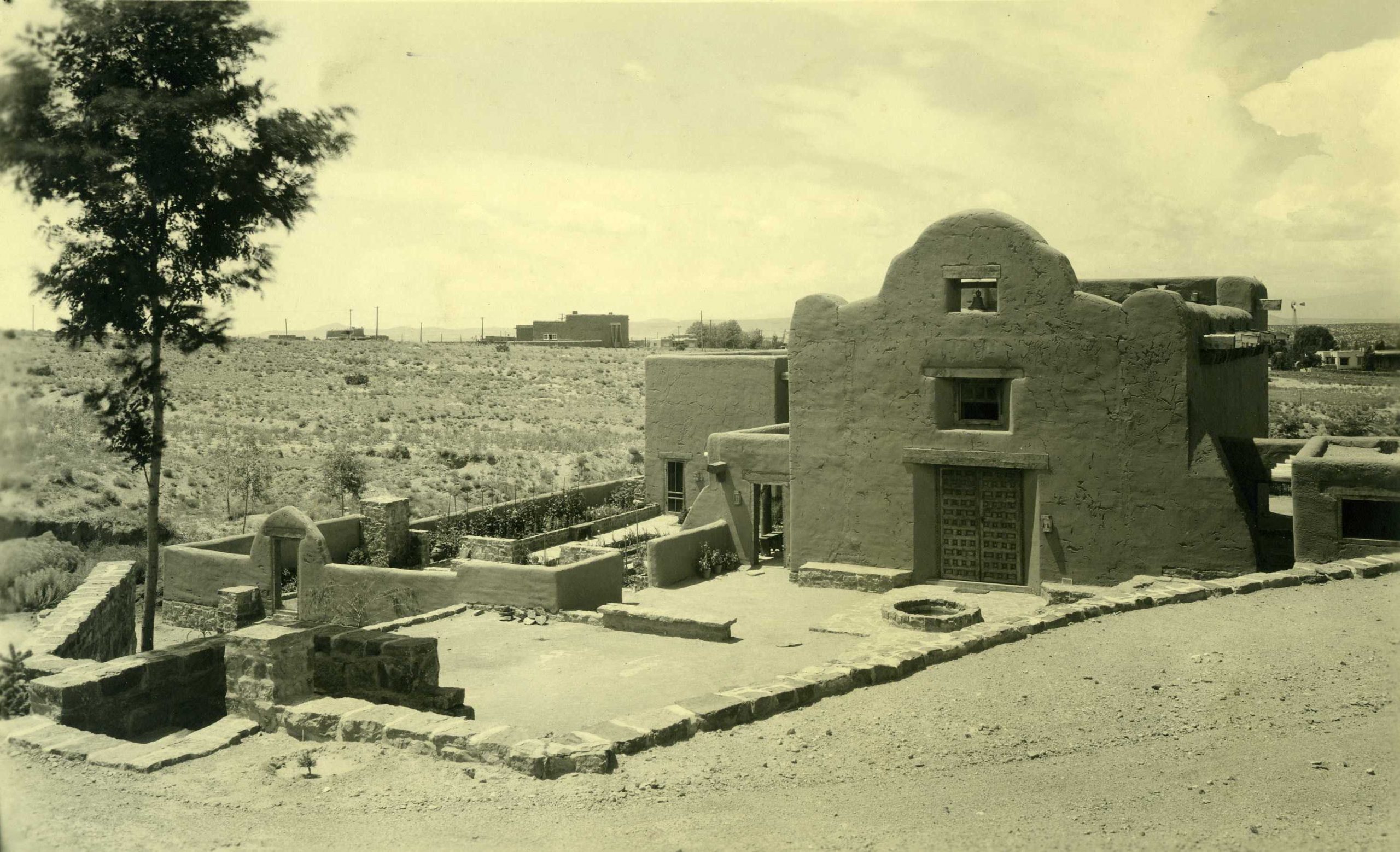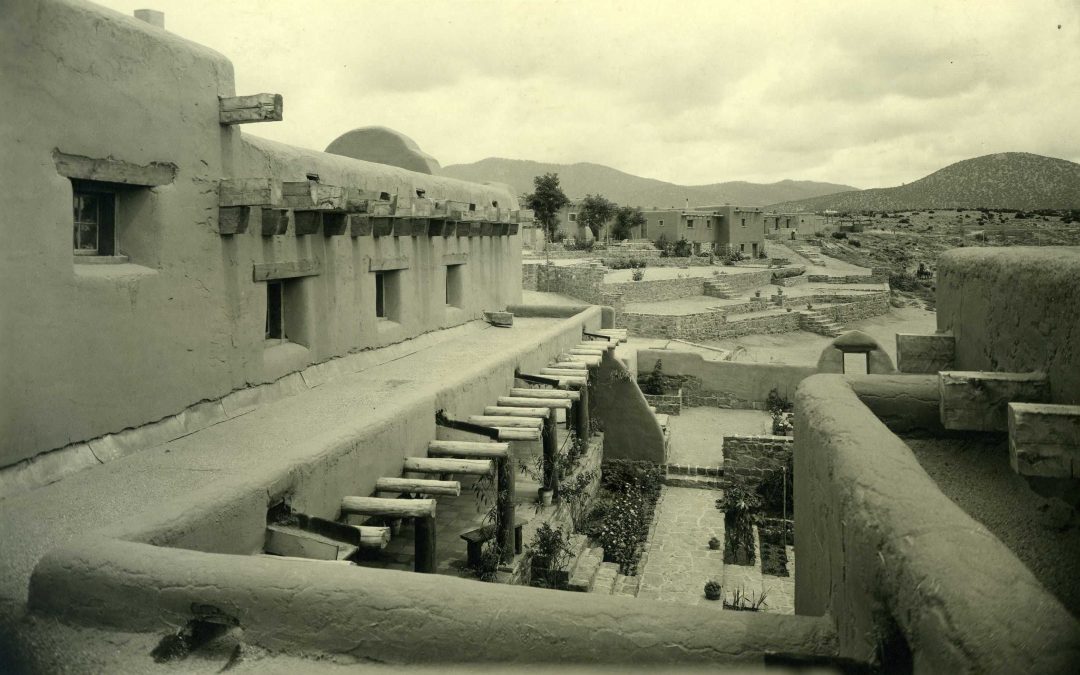Community lives not only in people, but in places. Places like El Delirio, originally home to Amelia Elizabeth and Martha Root White and now the home of the School for Advanced Research. Thanks to the vision of so many people—beginning with the White sisters and extending to past and current SAR presidents, scholars, artists, members, donors, and staff—our campus has just been recognized by the Historic Santa Fe Foundation and added to their Register of Resources Worthy of Preservation.

In 1923 the White sisters, far from their home in New York City, bought a small adobe on Garcia Street. Drawing inspiration from nearby Pueblo communities, as well as Santa Fe’s Spanish-Pueblo Revival style, they immediately set about transforming their property into El Delirio, a place where artists and intellectuals gathered for conversation and celebration.
In SAR’s application to the HSFF, Nancy Owen Lewis and Jean Schaumberg describe the sisters’ house:
The 5,600 square-foot stucco-covered adobe structure, completed in 1927, now serves as SAR’s administration building. Meetings and lectures are hosted in the White sisters’ former living room, now the Eric E. Dobkin Board Room. Distinctive features include hand-carved Mission style doors and exposed carved beams and corbel ends. The room, with its 16- to 22-foot ceiling, sports vigas and aspen latillas, painted red, white, and black, and set herringbone style in alternating sets of four to five. The choir loft remains as does the 19th-century tin chandelier likely made in Mexico. Much of the furniture in the room—including benches, chests, wardrobes, and tables, many said to be of Spanish-colonial design—were purchased by or given to the White sisters as gifts (Kingman 1991). Some of the artwork displayed on the walls is also from their estate, including three murals by San Ildefonso artists Awa Tsireh (Alfonso Roybal) and Oqwa Pi (Abel Sanchez) and an elk hide depicting a buffalo hunt by Shoshoni artist Katsidkodi.

The White sisters’ original living room, now SAR’s Eric S. Dobkin Boardroom.
The White sisters’ dining room now houses the office of SAR’s president. The door is framed by a tropical motif of pineapples and birds, traditional Victorian symbols of hospitality. Elizabeth purchased the filigree wrought iron gates during a trip to Spain. The floor tiles were copied from the Prado in Madrid. A wood ceiling carved by William Penhallow Henderson is painted in red and blue. On the far end is a reredos or altar screen given to the White sisters by archaeologist Sylvanus Morley, who purchased it from a church in Guatemala destroyed by an earthquake. At Elizabeth White’s request, Gustave Baumann replaced its crucifixion scene with angels and lutes—considered more appropriate for a dining room.
In 1972 Elizabeth White left the property to SAR, which moved onto campus the next year and began the process of both preserving the historically significant structures and developing the facilities needed for an anthropological research institution.
Although the White sisters’ home is fascinating and the buildings themselves historically significant, they are also part of a story that is still being written by the many scholars, artists, and SAR members who gather to work together and learn from each other year after year. Recognition of the historic built environment preserves not only the footprint of the past, but also the relationships that flourished there. “The beauty of our campus has inspired countless fresh ideas and works of art among the scholars and artists who have lived here during the nearly half century since it was bequeathed to SAR by Elizabeth White,” says SAR president Michael F. Brown. “We are delighted to have El Delirio’s architectural importance recognized by the Historic Santa Fe Foundation.”


SAR has recently brought together its board members and supporters in a focused effort to revitalize some areas of the historic campus. Director of development Laura Sullivan observes, “The legacy of community is clearly visible in the way our board and other members have come together to help fund campus improvements with their donations. With this assistance, we are better able to steward our historic estate, ensuring that future generations can experience the beauty of the buildings and grounds.”
Times change, and with retrospect, we come to understand the limitations of the past. But the value of community remains, and our campus has always been a place of community, whether we’re gathering in person or virtually, in Santa Fe or in cyberspace. Just as our community has been nourished by our historic campus and grown far beyond it, our current intellectual and artistic work has been nourished by that of our predecessors and expanded in directions they could not have conceived. We preserve the path between past and present so that we can continue to walk toward the future, enjoying the view and one another’s company.

El Delirio, home of the White sisters, built in 1927 by William Penhallow Henderson.
